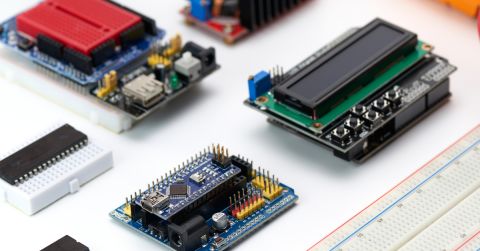Navigating the Current: 9 Electronic Component Supply Chain Trends
It wasn't that long ago when many electronic components were hard or impossible to source. This shortage of components hampered innovation and production across the industry. Today, the tides have largely turned. As 2023 comes to a close, we are in a period of ample component availability and robust inventories for most categories, much to the relief of electronic device manufacturers, product designers and engineers.
The transition from scarcity to abundance didn’t just happen. It was the result of extensive collaboration among manufacturers, suppliers and policymakers. These efforts produced results, leading to shorter lead times and increased component availability. Nevertheless, some products are still hard to find, and it is important to remain vigilant. The possibility of future supply chain disruptions remains high due to rising geopolitical tensions, new compliance requirements, unpredictable climate events and other factors.
In this article, we will examine nine trends that are shaping the future of the electronic component supply chain.
Trend 1: Continued Recovery from Component Shortages
Figure 1 illustrates the overall rebound in supply over the past two years, with most component categories showing improvement, although not all.
Nexar Spectra Electronic Design to Delivery Index – Industry Supply (September 2023)

Figure 1 – Data from Nexar Spectra EDDI shows how supply has improved over the past two years.
While component sales boomed in 2022, the electronics industry has experienced slower growth in 2023 and a rebalancing of inventory across the market. This adjustment is part of the industry's response to the new demand-supply dynamics and is a step towards stabilizing the supply chain. The outlook for 2024 indicates that the industry will continue to recover from the shortages experienced in previous years, with improved inventory levels and component availability for most categories.
Trend 2: Rising Demand and Shortages for Specific Component Categories
While the overall supply of components improved from 2021-2023, over the past year passive components have shown a decline in inventories for ten straight months (see Figure 2), according to data from the Spectra EDDI Supply Index. Power product inventories have also shown a modest decline since the beginning of 2023 (see Figure 3).
Spectra Supply Index for Passive Components (Sept. 23)

Figure 2 – Passive component inventories have declined for 10 months straight
Spectra Supply Index for Power Products (Sept. 23)

Figure 3 – Power product supplies for the past 12 months[1][2]
Beyond the low inventory levels that pervade the passives category, persistent demand for other products – including IGBTs, microcontrollers, microprocessors and electrical panels – is being driven by the proliferation of electric vehicles (EVs) and renewable energy solutions. This growing demand continues to make some parts difficult to source.
Trend 3: Elevated Component Prices
Component prices increased in the first half of 2023, but they are expected to flatten out as we approach the end of the year. However, there is the potential for price increases in certain component categories throughout 2024 due to ongoing demand and supply discrepancies. The complex and multifaceted pricing landscape in the component industry suggests that companies should be prepared for various price fluctuations as we head into 2024.
Trend 4: Resilient Supply Chain Strategies
The adoption of resilient supply chain strategies has helped device manufacturers navigate component shortages and ensure a steady supply of essential components. These strategies include advanced inventory management, diversification through engagement with multiple suppliers, and the utilization of component database software and analytics.
Designers and engineers play a critical role in streamlining designs to reduce complexity, cost, and reliance on scarce components. They are also modernizing older designs to align with current market demands and component availability. Additionally, engineers are investing more time in identifying suitable replacement parts, exploring alternative sourcing options for components in short supply, and conducting comprehensive component testing to ensure that replacements do not compromise product quality or functionality.
Trend 5: Government and Industry Collaboration
The global semiconductor industry has invested over $500 billion in more than 80 new chipmaking facilities between 2021 and 2023, driven in part by government initiatives and funding. This significant investment in production capacity will help alleviate future chip shortages and meet the rising demand in high-growth areas such as automotive and high-performance computing.
Increased collaboration between governments and industry stakeholders will continue to be essential to bolster the supply chain. Organizations like SEMI have formed partnerships to monitor and report on the status and projections of the industry, aiding in the recovery projection for 2024. Such collaborations are vital for tracking and analyzing market trends to better prepare for future demands and challenges.
Trend 6: Enhanced Supply Chain Visibility
To navigate the turbulence of the electronic component supply chain, enhanced visibility is paramount. Companies are deploying digital capabilities that provide real-time industry data and enable collaboration with supply chain partners to achieve control tower visibility of key indicators. This visibility allows companies to rapidly respond to supply chain challenges with agility and adaptability.
Trend 7: Global Geopolitical Impacts
Geopolitical conflicts will continue to disrupt supply chain operations and pose challenges in 2024. These geopolitical issues can affect demand, supply and the overall operational efficiency of the industry, while also leading to intermittent shortages in certain component categories.
To minimize the impact of geopolitical disruptions, companies are diversifying their sourcing strategies and exploring alternative markets. This includes seeking suppliers from different regions and countries to reduce reliance on single sources. Additionally, governments and industry organizations are working together to address geopolitical challenges and promote stability in the component supply chain.
Trend 8: Sustainability and Ethical Sourcing
The component industry is experiencing a growing emphasis on sustainability and ethical sourcing practices. Companies are recognizing the environmental and social impacts associated with their operations and are actively seeking suppliers who prioritize responsible sourcing and sustainable manufacturing. By promoting transparency and accountability throughout the supply chain, these companies aim to build trust with consumers and stakeholders. Additionally, by aligning with environmentally conscious suppliers, organizations can minimize the risk of supply chain disruptions that may arise from environmental or social issues.
Trend 9: Risk Management and Contingency Planning
Manufacturers are placing increased importance on risk management and contingency planning to mitigate potential disruptions. They are conducting thorough risk assessments to identify vulnerabilities within their supply chains and developing robust contingency plans accordingly. This includes diversifying supplier networks, qualifying alternate sources of components, and maintaining adequate safety stock levels. By proactively preparing for potential disruptions, companies can minimize the impact on production and maintain high levels of customer satisfaction.
Charting the Course of Tomorrow’s Component Supply Chain
In summary, the electronic component industry has made significant strides since the era of pervasive part shortages, thanks to collaborative efforts and strategic measures. In this ever-evolving ecosystem, the ability to anticipate and respond to changes effectively will be the hallmark of success. By staying adaptable, embracing innovation and fostering collaboration, your organization will be well-positioned to navigate the complexities of the component supply chain landscape in the years to come.










